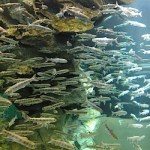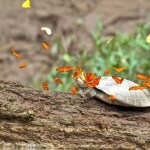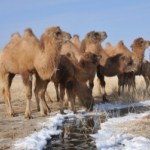salt
The Michigan Physiological Society, a chapter of the American Physiological Society, held their 3rd annual meeting last week. As mentioned in a prior post, the keynote address was given by Comparative Physiologist Dr. Hannah Carey (University of Wisconsin School of Veterinary Medicine). You can read about her research in the prior post.
Here are other highlights from the meeting:
Seminars:
Photo of crayfish by "Krebse in Österreich", own work, CC BY 2.0, https://commons.wikimedia.org/w/index.php?curid=858592
...or as I prefer to view them:
Image of crayfish dinner By Игоревич (Own work…
Image of Biwa salmon from the Lake Biwa Museum (http://www.lbm.go.jp/english/exhibits/aquarium.html)
It is not surprising that Biwa salmon (image above), a subspecies of Oncorhyncus masou, do not adapt to seawater very well after having been landlocked in Lake Biwa, Japan for the last 500,000 years or so. Researchers from Hokkaido University and Shiga Prefecture Fishery Experiment Station in Japan wanted to know what caused the salmon to lose their ability to thrive in salt water. In a new paper published in the American Journal of Physiology they compared the sodium/potassium pumps in…
Amazonian butterflies drinking turtle tears.Image from: Jeff Cremer / Perunature.com
The Amazon region is notoriously deficient in sodium because of its large distance from the ocean and because the Andes mountains block the delivery of windblown minerals from the West. Some minerals travel from the east, but much of the air is cleaned by rain before the minerals can make it to the western region of the Amazon Basin.
So if you were a butterfly, where would you find a readily available source of salt in the Amazon? The answer is not very obvious, unless you look at the photo of a yellow-…
Image by He Meng, from Nature News
Bactrian camels thrive in conditions considered harsh by many standards: very dry, cold, high elevations. Researchers now suspect their physiological adaptations of high blood sugar, high salt diets, and increased body fat may have evolved to help the animals cope with their environment. For humans, those symptoms could lead to heart disease, but for the Bactrian camel, they are considered physiological, i.e. totally normal.
A paper published in Nature Communications describes the genomic variations in wild and domesticated Bactrian camels. What they found…
Our lab has a new paper coming out this week in the Journal of Molecular Biology (JMB):
The Glutamate Effect on DNA Binding by Pol I DNA Polymerases: Osmotic Stress and the Effective Reversal of Salt Linkage
I'm going to talk about a few highlights here, but if you actually want the full article, say so in the comments or email me directly and I'll send you a reprint, because unless you or your university has a subscription to the Journal of Molecular Biology, you'll only be able to see the abstract.
The paper comes primarily from the Ph.D. dissertation of Daniel Deredge and osmotic stress…


